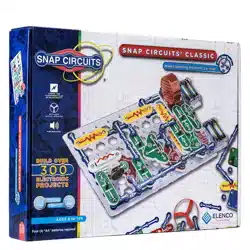Loading ...
Loading ...
Loading ...

5
(Part designs are subject to change without notice).
The
base grid functions like the printed circuit boards found in most
electronic products. It is a platform for mounting parts and wires (though the
wires are usually “printed” on the board.
The blue
snap wires are just wires used to connect other components, they
are used to transport electricity and do not affect circuit performance. They
come in different lengths to allow orderly arrangement of connections on the
base grid.
The red and black
jumper wires make exible connections for times
when using the snap wires would be difcult. They also are used to make
connections off the base grid (like the projects using water).
The
batteries (B1) produce an electrical voltage using a chemical reaction.
This “voltage” can be thought of as electrical pressure, pushing electrical
“current” through a circuit. This voltage is much lower and much safer than
that used in your house wiring. Using more batteries increases the “pressure”
and so more electricity ows.
The
slide switch (S1) connects (ON) or disconnects (OFF) the wires in a
circuit. When ON it has no effect on circuit performance.
The
press switch (S2) connects (pressed) or disconnects (not pressed) the
wires in a circuit, just like the slide switch does.
Resistors “resist” the ow of electricity and are used to control or limit the
electricity in a circuit. Snap Circuits
®
includes
100W (R1), 1KW (R2), 5.1KW
(R3), 10KW (R4), and 100KW (R5) resistors
(“K” symbolizes 1,000, so R3
is really 5,100W). Materials like metal have very low resistance (<1W) and
are called conductors, while materials like paper, plastic, and air have near-
innite resistance and are called insulators. Increasing circuit resistance
reduces the ow of electricity.
The
adjustable resistor (RV) is a 50KW resistor but with a center tap that
can be adjusted between 0W and 50KW. At the 0W setting, the current must
be limited by the other components in the circuit.
The
photoresistor (RP) is a light-sensitive resistor, its value changes from
nearly innite in total darkness to about 1000W when a bright light shines on it.
The
microphone (X1) is actually a resistor that changes in value when
changes in air pressure (sounds) apply pressure to its surface. Its resistance
typically varies from around 1KW in silence to around 10KW when you blow
on it.
A light bulb, such as in the
2.5V and 6V lamps (L1 and L2), contains a
special wire that glows bright when a large electric current passes through it.
Voltages above the bulb’s rating can burn out the wire.
The
motor (M1) converts electricity into mechanical motion. Electricity is
closely related to magnetism, and an electric current owing in a wire has a
magnetic eld similar to that of a very, very tiny magnet. Inside the motor is
three coils of wire with many loops. If a large electric current ows through
the loops, the magnetic effects become concentrated enough to move the
coils. The motor has a magnet inside so, as the electricity moves the coils to
align them with the permanent magnet, the shaft spins.
The
speaker (SP) converts electricity into sound. It does this by using
the energy of a changing electrical signal to create mechanical vibrations
(using a coil and magnet similar to that in the motor), these vibrations create
variations in air pressure which travel across the room. You “hear” sound
when your ears feel these air pressure variations.
The
whistle chip (WC) contains two thin plates. When an electrical signal is
applied across them they will stretch slightly in an effort to separate (like two
magnets opposing each other), when the signal is removed they come back
together. If the electrical signal applied across them is changing quickly, then
the plates will vibrate. These vibrations create variations in air pressure that
your ears feel just like sound from a speaker.
The
red and green LEDs (D1 and D2) are light emitting diodes, and may
be thought of as a special one-way light bulb. In the “forward” direction
(indicated by the “arrow” in the symbol) electricity ows if the voltage exceeds
a turn-on threshold (about 1.5V for red and 2V for green); brightness then
increases. A high current will burn out the LED, Snap Circuits
®
LEDs have
internal resistors to protect them. LEDs block electricity in the “reverse”
direction.
Capacitors are components that can store electrical pressure (voltage) for
periods of time, higher values have more storage. Because of this storage
ability they block unchanging voltage signals and pass fast changing
voltages. Capacitors are used for ltering and oscillation circuits. Snap
Circuits
®
includes
0.02mF (C1), 0.1mF (C2), 10mF (C3), 10mF (C4), 470mF
(C5) capacitors, and a variable capacitor (CV).
The variable capacitor can
be adjusted from .00004 to .00022mF and is used in high frequency radio
circuits for tuning. The whistle chip (WC) also acts like a 0.02mF capacitor in
addition to its sound properties.
The
antenna (A1) contains a coil of wire wrapped around an iron bar.
Although it has magnetic effects similar to those in the motor, those effects
are tiny and may be ignored except at high frequencies (like in AM radio).
About Your Snap Circuits
®
Parts
Our Student Guides give much more information about your parts along with a complete lesson
in basic electronics. See www.elenco.com/faqs for more information.
Loading ...
Loading ...
Loading ...
